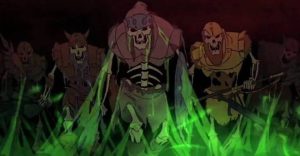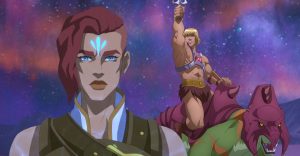10 Best Video Games Based On Books

Whether it be comics, short stories, or traditional prose, film and print have enjoyed a successful relationship for decades with about two-thirds of all Best Picture winners at the Academy Awards being based on works of the written word. Despite this, books’ storied history of successful adaptations has not yet crossed as heavily over to video games.
Despite this, the various pieces of literature, from modern horror to classic poetry, that have been successfully adapted into video games prove there’s plenty of potential for these two mediums to work together, as seen in many of today’s most famous franchises.
10 The Witcher Series

With three mainline games and a number of expansions and spin-offs, The Witcher is one of the most beloved RPG franchises in gaming. Where Geralt of Rivia and his adventures began, though, was with a 1986 short story by Polish author Andrzej Sapkowski. This short story, simply titled “Wiedzmin’ (or “Witcher” in English), eventually grew into a series consisting of a number of novels and short story collections about the titular Witcher.
Though their relationship has had its ups and downs with disagreements over royalties and licensing fees, Sapkowski and developer CD Projekt Red have somewhat recently re-negotiated their contract, meaning we’re likely to continue getting more games and merchandise tied to the Witcher IP.
9 Metro Series

In the Metro series, players try to survive life in a post-apocalyptic Russia that has seen its surface become completely inhospitable after nuclear bombs leave the area bathed in intense radiation. While the first game acts as a fairly traditional adaptation of Russian author Dmitry Glukhovsky’s 2002 novel of the same name, the games and books actually go back and forth to fill in the narrative after that.
To get the full main story in order, players should continue with novel Metro 2034, game Metro: Last Light, novel Metro 2035, and game Metro Exodus. It’s a complex back-and-forth, but it makes for an interesting symbiotic relationship between mediums that’s rarely found.
8 I Have No Mouth, And I Must Scream

Harlan Ellison’s short story I Have No Mouth, and I Must Scream is an intense short story from his collection of the same name that brings together science fiction and pure horror. The story, set in the far future, follows the last few people alive on Earth after a supercomputer develops an insatiable hatred for humanity.
The computer, in control of everything, uses each person’s fears and insecurities to make their lives as miserable as possible. The game follows this general premise and alters it, instead having players guide each of five survivors through simulated situations meant to prey on their flaws and fears. Plus, with most of the horror being psychological, I Have No Mouth, and I Must Scream is still terrifying, despite its age.
7 Cyberpunk 2077

Cyberpunk 2077 continued CD Projekt Red’s tradition of basing their games on established properties, though, with this open-world foray into science fiction, they found their inspiration in a different type of book. Instead of a traditional novel, Cyberpunk 2077 is based on the Cyberpunk series of tabletop roleplaying books written by Mike Pondsmith.
The roleplaying books follow a narrative progression from the original (taking place in 2013) to the most recently released Cyberpunk Red (2045), with the video game taking place after all of them (2077). While the game retconned a few dates and details from the tabletop book, there’s continuity with many of the characters and events present in both.
6 Tom Clancy’s Rainbow Six

While dozens of games sport the Tom Clancy name and branding, few are actually based on novels that the author wrote. Penning best-selling books like The Hunt For Red October and The Sum of All Fears, Clancy also co-founded developer Red Storm Entertainment in 1998, which released the game Rainbow Six based on his novel of the same name.
Eventually, Ubisoft purchased the Tom Clancy name, spreading it to franchises like The Division and Splinter Cell that aren’t actually based on Clancy novels. These series have continued long after Clancy’s unexpected 2013 death.
5 S.T.A.L.K.E.R. Series

S.T.A.L.K.E.R.‘s connection to literature isn’t quite as close as a direct adaptation, but it’s clear that much of the game’s setting and premise stem from Arkady and Boris Strugatsky’s 1977 work of Russian science fiction Roadside Picnic.
S.T.A.L.K.E.R. is, more specifically, an adaptation of Andrei Tarkovsky’s similarly-titled 1978 movie Stalker, which is in turn a psuedo adaptation of the aforementioned Russian work. Both versions of the story focus on people adventuring into mysteriously tainted “Zones” filled with danger and the promise of wealth, navigating invisible traps and inversions on known physics.
4 Dante’s Inferno

Visceral Game’s 2010 Dante’s Inferno may have eschewed any social commentary and subtlety present in Italian poet Dante Alighieri’s original 12th classic work of the same name, but the violent third-person slasher still took much thematic inspiration from this famous depiction of the Christian underworld.
While wildly different in tone and plot, Dante’s Inferno did succeed in bringing to life memorable adaptations of Dante’s various leveled rings of the underworld, each one thematically based on a different deadly sin and filled with appropriately designed monstrosities. The game’s narrative may have ended on a cliff hanger, but, unfortunately for fans, the Dante’s Inferno sequel doesn’t appear to be happening.
3 Call Of Cthulhu

The horror stories of author H. P Lovecraft have indirectly inspired many games, but a few, like developer Cyanide’s 2018 Call of Cthulhu, take more direct inspiration from the famous mythos. Though their reliance on cosmic horror and what’s not seen often make the author’s work difficult to adapt, Call of Cthulhu cleverly mixed a number of stories into one creepy, atmospheric first-person mystery game.
Technically based on the 1981 tabletop game of the same name, which was, in turn, based on the original fiction, the game forces players to question the protagonist’s senses and rely on intelligence instead of force, both common elements of Lovecraftian horror.
2 Parasite Eve Series

Hideaki Sena’s 1996 sci-fi horror novel Parasite Eve asks the question, “What if mitochondria were actually part of a sentient being waiting to overtake the entire planet?” The premise may sound strange, but the novel went on to be the very first recipient of the Japanese Horror Novel Award and led to the development of both manga and video game series.
While the third and final game in the series largely removes itself from the narrative of the novel, the first two, Parasite Eve (1998) and Parasite Eve II (1999), act as sequels to the original novel.
1 Conan Exiles

The Conan intellectual property may owe its look, setting, and stories to a number of entrainment mediums, but they all started with Robert E. Howard’s 20+ stories, poems and essays published in the 1930s. These stories, set during the fictional Hyborian Age of Earth (between the sinking of Atlantis and the rise of known ancient civilizations), have been in the public domain since the 1960s and have inspired dozens of games in most every genre.
The most recent, though, is 2018’s Conan Exiles. In this open-world survival game, players don’t play the titular hero, but instead one of a number of exiles forced to survive both the barbaric wasteland environment, the monsters that call it home, and other humans looking to take what they can by force.
About The Author

















